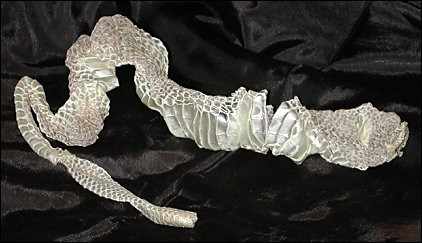
You may remember the old ads for a shampoo. You know, the ones that suggest if you had dandruff, you weren't fit to be around civilized people and certainly couldn't expect to cozy up to the opposite sex. Not mentioned, of course, was that a certain amount of dandruff is normal. We shed old, worn-out, surface skin bit by bit, but generally notice it only on the scalp--the infamous dandruff.
Not all animals shed skin this way. Some reptiles loosen the surficial
layer in major patches rather than little pieces, and snakes generally manage to shed
the entire outer portion of the skin as one unit. Finding such ghostly, inside-out
"snake skins" entangled with plant material or rocks used to anchor the old
skin is common in the desert. Remarkably, each scale can be clearly seen, and even the
covering of the eye is apparent. Based on this shedding of the skin, some peoples
thought snakes were able to rejuvenate themselves, and snakes became symbols of life
and health, as displayed on the physicians' staff. 
Contributor: Florence E. Schwein, University of Texas at El Paso.
Desert Diary is a joint production of the Centennial Museum and KTEP National Public Radio at the University of Texas at El Paso.

Shed skin of a rattlesnake. The skin has been turned inside out during the shedding process.
Orr, R. T. 1982. Vertebrate biology. 5th ed., Saunders College Publishing, Philadelphia. 568 pp.